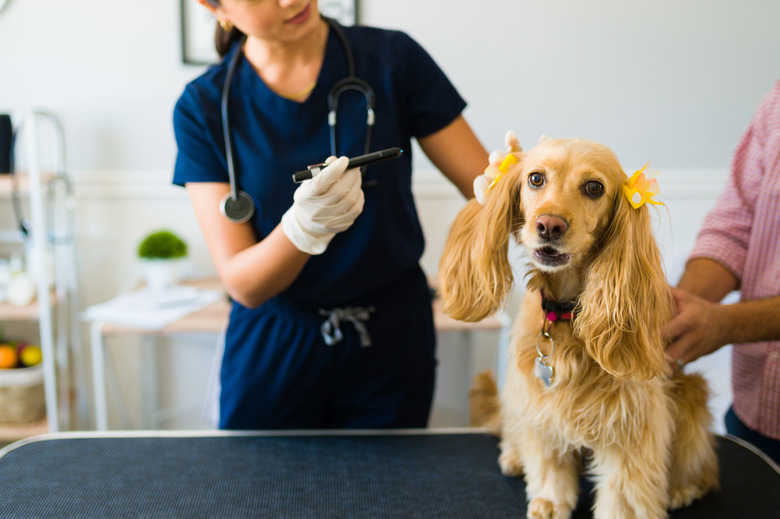Normal Creatinine Levels In Dogs
The kidney's main function in a dog is to filter the blood from toxic buildup and remove the waste through excretion, commonly called urination. Creatinine is a toxic metabolite found within this toxic buildup and is used as one of two key indicators to measure kidney functions and help diagnose kidney disease in dogs. A certain level of normal creatinine range is expected to be in a dog's blood. Any variation above or below this normal range indicates a problem with the kidneys which may require further diagnostic work and treatment.
Physiological factors that affect blood creatinine concentration
Physiological factors that affect blood creatinine concentration
Certain physiological factors affect blood creatinine levels, such as the dog's age, body weight, and breed. Blood creatinine increases in puppies up to one year. In healthy geriatric dogs, creatinine levels are similar to that observed in young adults. Keep this in mind when caring for your senior dog. Blood creatinine is generally higher in large dog breeds, and in heavier dogs. Large muscle mass may explain moderate increases in blood creatinine, while muscle atrophy may decrease blood creatinine values.
Symptoms of elevated creatinine in dogs
Symptoms of elevated creatinine in dogs
Symptoms of kidney disease in dogs can include drinking excessive amounts of water, frequent urination, loss of appetite, vomiting, weight loss, dehydration, and unkempt fur appearance, though your dog may not have all of these symptoms. You may not notice symptoms at first because they appear gradually. Keeping an eye on your dog's body language may also give you a sign to how they are feeling. Usually, by the time an owner notices that there is a problem, the disease is well under way and there have already been blood chemistry changes, most notably an increased creatinine level.
What is the normal creatinine level in dogs?
What is the normal creatinine level in dogs?
The normal levels of creatinine in a dog are 0.6 to 1.3. In order to determine what the dog's creatinine level is, a small sample of blood is drawn and placed into a special "separator" vacuum blood tube. The blood is allowed to clot and is then "spun down" in a centrifuge, allowing the red blood cells and platelets to fall under the separation media, leaving only the serum for testing.
A sample of serum is placed into the blood chemistry panel machine to measure the levels of specific indicators for a number of internal organ systems, including BUN (blood urea nitrogen) and creatinine to measure kidney function. When the test is complete, a result page is printed showing the normal ranges for each function tested and the sample levels.
What your dog's creatinine levels mean
What your dog's creatinine levels mean
A creatinine level of 1.4 or greater can indicate dehydration, especially with an elevated BUN. If the creatinine level is continually elevated, it will indicate that the kidneys are not functioning properly and are not removing this substance from the blood at a high enough rate to keep the dog healthy. Your veterinarian will explain what to expect and the next steps that should be taken if results do not show normal creatinine levels.
Usually, your dog's body will try to compensate for a decline in kidney function by drinking more water and producing more urine to flush the creatinine from his system, therefore making it difficult to diagnose kidney disease by bloodwork alone, unless your veterinarian uses a lab that has the symmetric dimethylarginine (SDMA) test on their blood panels. Elevated SDMA reflects an impairment in the amount of blood passing through a specific part of the kidneys. Without the SDMA test, at least 2/3 of normal kidney function will have been lost before the creatinine level will begin to rise, but with an SDMA test, a loss in kidney function can be detected much earlier. A urinalysis should also be done when a dog is suspected of having kidney disease.
Treatments for kidney disease in dogs
Treatments for kidney disease in dogs
Treatments for kidney disease include, but are not limited to, starting dogs on intravenous or subcutaneous fluid therapy to lower the toxin concentrations, which is usually successful for awhile, until the kidneys degrade to the point that they can no longer filter the blood at all. Veterinarians often give vitamin injections and prescribe a low-protein diet, which is considered better for the kidneys. However, feeding a homemade low-protein diet is not recommended, because such diets may not be as nutritious and balanced as prescribed diets that have been evaluated by nutritionists. During treatment, make sure your dog has access to fresh water at all times and is allowed to drink as much as desired.
If your dog's creatinine level indicates kidney disease, talk to your veterinarian about the stages of the disease, treatments, and what to expect. If you have pet insurance, talk to them about what treatments they cover.


